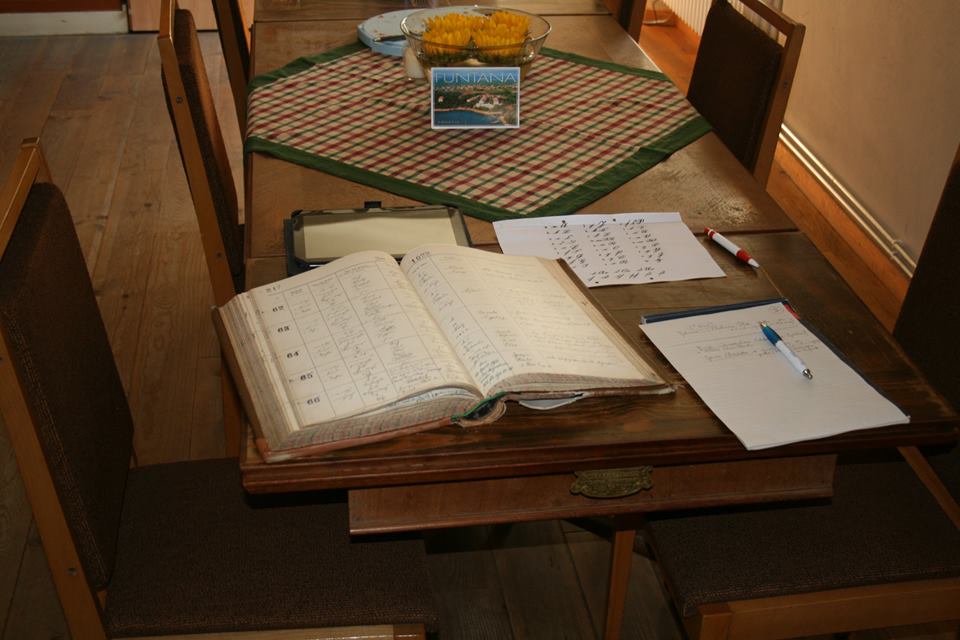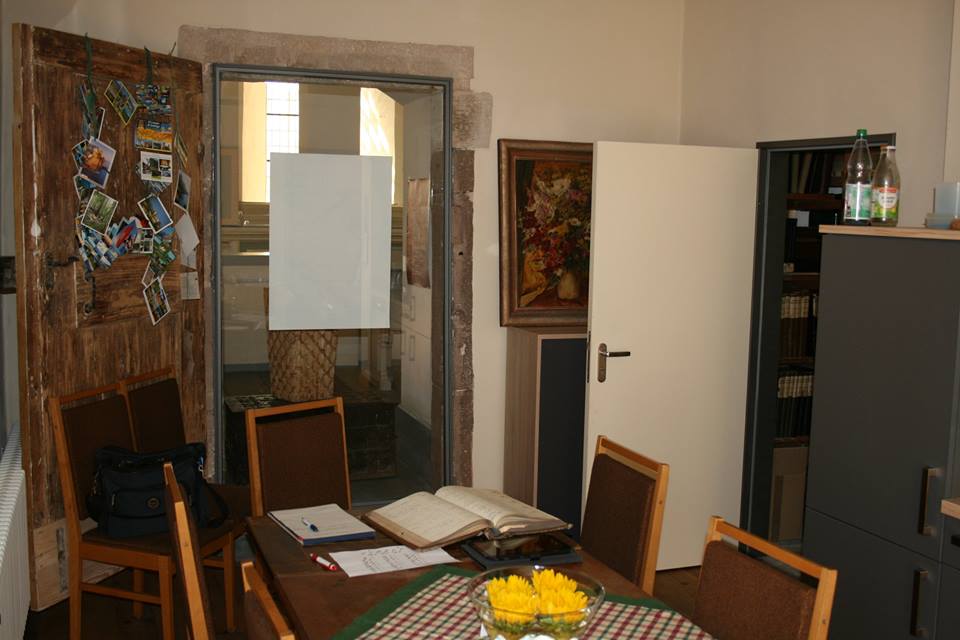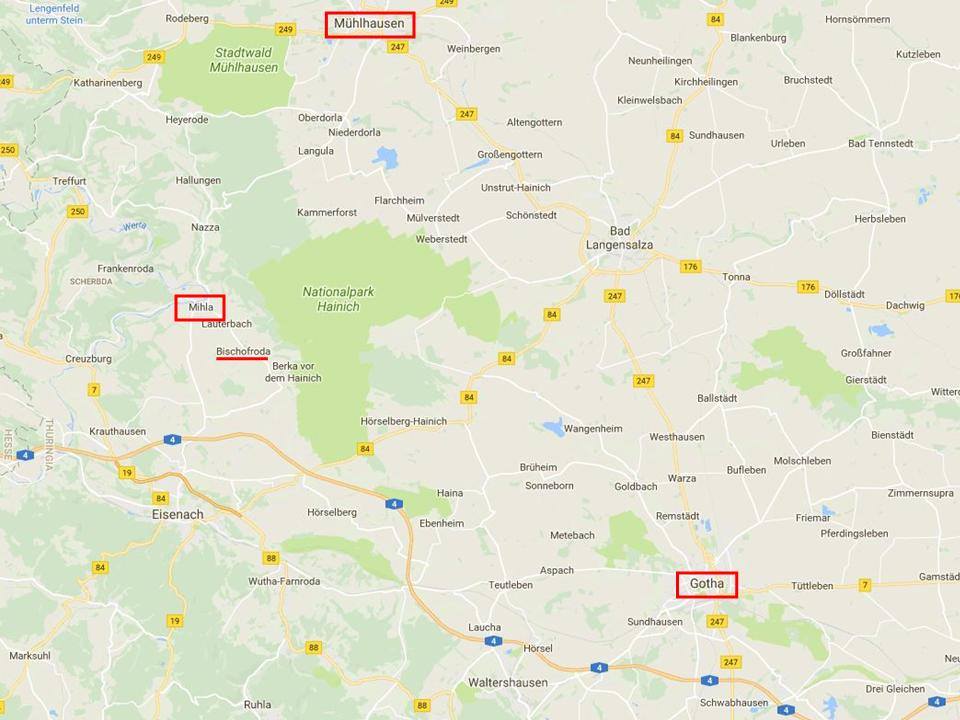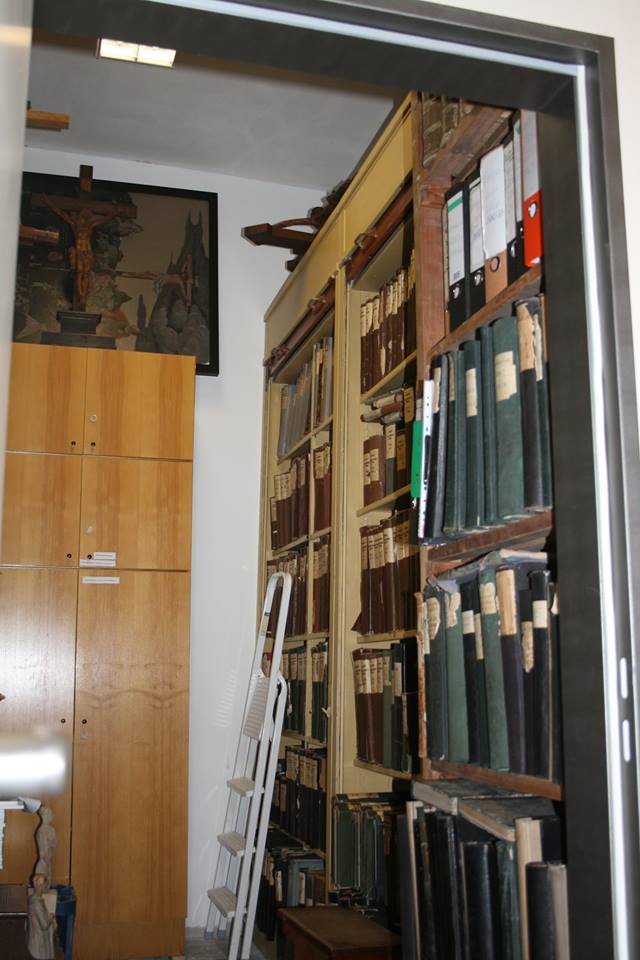37. Reporting on my June 2017 search for Weis(s)enborns: the second day, Tuesday 20 June.
Posted on Facebook on 11 July 2017. I woke up at 4:30 am and did my usual morning reading. A group of some 30 children with accompanying staff were on the campsite. Some of the kids were already awake, or more likely hadn't slept all night. In the outdoors I sleep so fast that I cannot tell: I hadn't heard a thing. I drove to Gotha via Eisenach and there I took the old road to Gotha via Teutleben and Aspach, see the attached map on which I have outlined Milha, Mühlhausen, Bischofroda and Gotha. Parking in Gotha proved easy, even though it is a big city and the archive is located on the street leading to the main square. The lady with whom I had made my appointment was also the person who unlocks the main entrance to the archive. She was a few minutes late and carried a strawberry pie to celebrate her birthday with her colleagues. As workplace I was given the far end of the table in the coffee room, and free access to the little room with its walls covered with church registers, see the attached pictures. At 10 o' clock I was asked to clear my end of the table for coffee and pie. Eight people gathered for the birthday celebration. I stayed at my far end of the table and tried not to be an intruder. I was however offered coffee and a piece of pie, and treated as if I belonged to the party. I enjoyed listening to the casual conversation - of course in the local dialect - and chipped in a word here and there. I received a second coffee and piece of pie, to help clear the plate. I felt rather welcome, and wondered why this happens to me so often. I had a few Weissenborns in my database who had allegedly been born in Gotha in the 1830's and 1840's. Among these was Christian Weissenborn, a painter born in 1842, who had emigrated with his family to Milwaukee between 1880 and 1883. He is the great-grandfather of facebook friend Paul Weissenborn and great-great-grandfather of facebook friend Barb Stachurski. My search was however in vain. The lady of the archive pointed out that Gotha is a "Kreisstadt". This means that when someone says he/she is from Gotha, it can mean the city of Gotha or "Kreis Gotha", which encompasses a fair number of villages in a range of several kilometers around Gotha. I knew that films of the church registers of these villages are available in Eisenach. Those of Gotha are being filmed, and will also become available in Eisenach. When I had called the Landeskirchliches Archiv in Eisenach well over a month ahead of time, there was no opportunity for a visit in the week I had scheduled. The popularity of genealogy is clearly rising, as 3 years before I had no difficulty making an appointment even closer to the date. The churches make the registers available as a service, in addition to their core religious task and have limited facilities. I met the same fate - no opportunity - when I was in Erfurt, about which I shall write later. My appointment with the archive in Bad Langensalza was cancelled shortly before my trip, I assume for the same reason: more visitors than the archive could accommodate. The few families Weissenborn I found in the 19th and 20th century kept me busy for the entire morning. First thing after lunch I scanned the index for the marriage register of the 18th century. Bingo! I found a Johann Heinrich, married in 1766, and 6 children. Johann Heinrich had initially been miller, and later became brandy distiller. I also found his father, Johann Nicolas, married in 1739, and 4 children. Johann Nicolas had been miller on the Töxfleben mill in Gotha. He was the eldest son of Hiob Weissenborn, citizen of Hochheim. I found a further Johann Heinrich, married around 1757, the youngest son of this Hiob, with 6 children. Hiob Weissenborn from Hochheim sounded familiar to me. Only yesterday did I find the time to look up Hiob in my database. Indeed there he was: great-grandson of Balthassar Weissenborn from Mihla. Balthassar was born around 1570. I was rather pleased with this harvest, in particular since I have found a Jonas Weissenborn in Mühlhausen, who came from Mihla in 1575. Jonas may well prove to be an uncle of Balthassar, which would yield a fine pedigree. In the evening I went again to Meltem's kebapshop in Mihla, and had salad and pizza. Then I drove to Bischofroda, and found Günter and Rosa at home. When Günter showed me his pedigree, I asked if I could return on Thursday evening to copy the data, as I was rather tired. The campsite was now deserted: I was the only soul on its 2 hectares. I turned in at sunset, around 9:30 pm. Wednesday was going to be a very long day.



